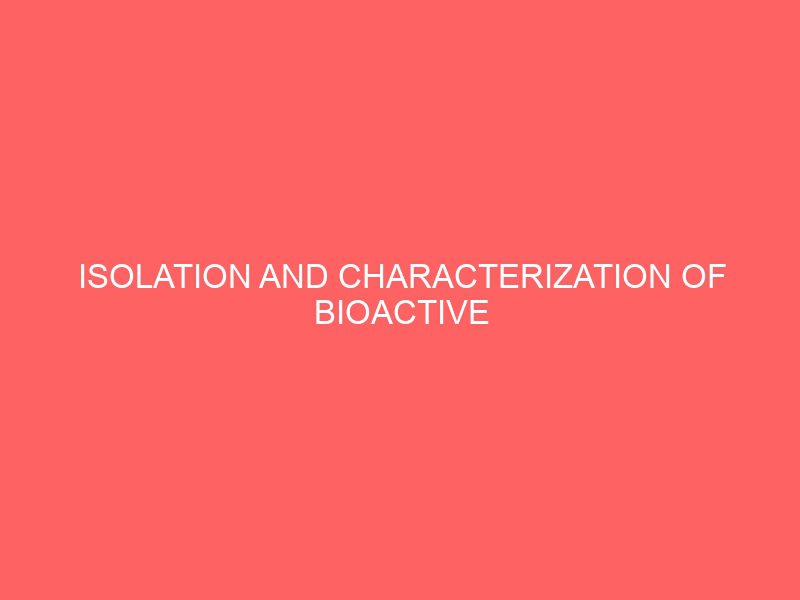Description
CHAPTER ONE
1.0 INTRODUCTION
Over the years the world traditional medicine has been known to take its source from higher plants and their extracts in the treatment of diseases and infections (Sofowora, 1983). Until 19th century, when the development of chemistry and synthetic organic chemistry started, medicinal plants were the sources of active materials used in healing and curing human diseases. Before the advent of modern methods of producing drugs, medicinal plants such as Allium sativum, Azadirchata indica and Citrus limonum were used in treating both malaria and typhoid fever. Also some plant leaves were used in treating skin rashes and to heal wounds. Likewise, modern pharmaceuticals rely heavily on these medicinal plants for their raw materials such as cocoa leaves and opium plant from papaver species for analgesics. The active principles of plants differ from one plant to another due to the diversity in biological activities (Sofowora, 1983; Kubmarawa et al., 2007; Krishnaiah et al., 2009).
Traditional medicinal practice has been established for centuries in many parts of the world. Numerous plants and herbs are used globally by traditional medicine practitioners. The practice is known to vary from one country to another (Sofowora, 1984). Extracts from the various plant parts (leaves, stem bark and roots) of various higher plants are used in herbal medicine production (Sofowora, 1983, 1984, 1993). Plants` extracts are given singly or as concoctions for the treatment of various ailments. In actual sense more than 75% of the world population depend on these various forms of concoctions and herbal decoctions for the treatment of infections (Robenson and Zhang, 2011). Phytochemical constituents are the basic raw materials source for the establishment of pharmaceutical industries (Mothana and Lindequist, 2005; Wojdylo et
1
al., 2007). The constituents present in the plant play vital roles in the crude drugs identity. Phytochemical screening is very important in identifying new sources of therapeutically and pharmacologically important compounds like alkaloids, anthraquinones, flavonoids, phenolic compounds, saponins, steroids, tannins and terpenoids (Akindele and Adeyemi, 2007).
Some plants such as Aloe vera, Alliium sativum, Maranta arundinacea, Pimpinella anisum and Arnica montana widely distributed in Africa, Asia and Southern part of North America have been reported to be the basis of treatment in human diseases and also as useful components in the development of new active components (Boudreau and Beland, 2006; Bunyapraphatsaraet al., 1996; Alan et al., 1995). The World Health Organization (WHO) estimates that 80 % of the world?s population relies mainly on herbal medicine for primary healthcare (Hong et al., 2010). In China, traditional medicine is largely based on around 5000 plants which were used in treating 40 % of urban patients and 90 % of rural patients (Abdel-Azim et al., 2011). In industrialized countries, plants have contributed more than 7000 compounds used in the pharmaceutical industries including ingredients in heart drugs, laxatives, anti-cancer agents, hormones, contraceptives, diuretics, antibiotics, decongestants, analgesics, ulcer treatments and anti-parasitic compounds (Simo, 2012). About 25 % of all prescription drugs dispensed by Western pharmacists is likely to contain ingredients derived from plants (Simo, 2012). These include: Laevodopamine from tropical legume Mucuna deeringiana, used for treating Parkinson disease (dos Santos et al., 2012). Picrotoxin derived from Anaminta cocculus, a tropical climbing plant from south East Asia, is used as a nervous system stimulant and in cases of barbiturate poisoning (Abebe and Haramaya, 2013). Reserpine, extracted from the root of the serpent-root, Rauwolfia
2
serpentine, is used for lowering blood pressure, as a tranquilizer and in India as a remedy for snake bites (Unnikrishnan, 2004). Eucalyptol obtained from species of eucalyptus, is a well-known antiseptic used in throat medicines, cough syrups, ointments, liniments, as inhalant for bronchitis and asthma. Eucalyptus is used throughout the world and is regarded as a universally available product (Eschler et al., 2000). Cultivation has replaced wild collection for the supply of some essential drugs used in modern medicine. The Madagascar rosy periwinkle (Cathrathus roseus) is widely cultivated in Spain and Texas for its alkaloids vinblastine and vinscristine, which are used for treating childhood leukaemia and hoolgkin disease (Bauer et al., 1996).
The best known example is probably aspirin, chemically related to a compound that was first extracted from the leaves and bark of willow tree, Salix alba and a herb meadow sweet, Filipino dula malaria. The anti-malarial drug quinine, extracted from the bark of a South American tree, Cinchona ledgeriana, was first brought to Europe (where malaria was widespread) in early 17th century by Jesuit priests (Fruhstorfer et al, 2001). It was once remarked that Oliver Cromwell died of malaria because he refused to be treated with a ?Jesuit? medicine. Synthetic guanine has now been developed for drug use, but the bark is still in use to treat certain heart arrhythmias and commercially sold as a bitter flavouring agent well known in tonic water (Fruhstorfer et al, 2001).
Also, the bark of yohimbe, Pausinnystalia yohimbe is used extensively in traditional healthcare system in West Africa (Robber and Tyler, 1999).
1.1 Statement of the Research Problem
About half of the number of death recorded in the tropical countries are largely due to infectious diseases (Iwu et al., 1999). This can be linked to the increasing bacterial
3
resistance to antibacterial drugs (Ojiako, 2014). Hence there is need to develop a more convenient and very active therapeutic antimicrobial agents.
1.2 Aim of the Research
The aim of this research work is to isolate and characterise bioactive components present in the plant.
1.3 Objectives of the Research
i. phytochemical screening of crude plant extracts,
ii. antimicrobial screening of the crude extract of the plant,
iii. isolation and identification of phytochemicals present in the extracts and
iv. antimicrobial screening of isolated/identified compounds.
1.4 Justification of the Research
Uapaca pilosa (Hutch) has been used in many tropical communities in traditional medicine for the treatment of protozoa, bacteria and fungi infections. To the best of our knowledge, the phytochemistry and antimicrobial activity studies of Uapaca pilosa have not been studied. Hence there is need to validate the ethnomedicinal uses of the plant.
4








